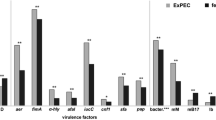Abstract
The susceptibility ofEscherichia coli strains with K1 surface antigen (K1+) and rods without this antigen (K1−) to the bactericidal action of normal bovine serum and human normal cord serum was determined. SeventyE. coli strains (35 K1+ and 35 K1−) were isolated from urine obtained from children with urinary tract infections. The strains investigated showed variable sensitivity to the bactericidal action of the sera.E. coli K1+ strains were characterized by lower sensitivity to bactericidal effect of the sera in comparison with K1− rods. The role of the particular mechanisms of complement activation in the process of killing of theE. coli strains was also determined.
Access this article
We’re sorry, something doesn't seem to be working properly.
Please try refreshing the page. If that doesn't work, please contact support so we can address the problem.
Similar content being viewed by others
Abbreviations
- C:
-
complement
- NBS:
-
normal bovine serum
- NCS:
-
normal cord serum
References
Alos J.-I., Lambert T., Courvalin P.: Comparison of two molecular methods for tracing nosocomial transmission ofEscherichia coli K1 in a neonatal unit.J.Clin.Microbiol. 31, 1704–1709 (1993)
Alvarez D., Merino S., Tomas J.M., Benedi V.J., Alberti S.: Capsular polysaccharide is a major complement resistance factor in lipopolysaccharide O side chain-deficientKlebsiella pneumoniae clinical isolates.Infect.Immun. 68, 953–955 (2000).
Bliss J.M., Silver R.P.: Coating the surface: a model for expression of capsular polysialic acid inEscherichia coli K1.Mol.Microbiol. 21, 221–231 (1996).
Bliss J.M., Garon C.F., Silver R.P.: Polysialic acid export inEscherichia coli K1 the role of KpsT, the ATP-binding component of an ABC transporter, in chain translocation.Glycobiology 6, 445–452 (1996).
Devine D.A., Roberts A.P., Rowe B.: Simple technique for detecting K1 antigen ofEscherichia coli.J.Clin.Pathol. 43, 76–78 (1990).
Devine D.A., Roberts A.P.: K1, K5 and O antigens ofEscherichia coli in relation to serum killingvia the classical and alternative complement pathways.J.Med.Microbiol. 41, 139–144 (1994).
Drogari-Apiranthitou M., Kuijper E.J., Dekker N., Dankert J.: Complement activation and formation of the membrane attack complex on serogroup BNeisseria meningitidis in the presence or absence of serum bactericidal activity.Infect.Immun. 70, 3752–3758 (2002).
Edinger D., Bello E., Mates A.: The heterocytotoxicity of human serum. I. Activation of the alternative complement pathway by heterologous target cells.Cell.Immunol. 29, 174–186 (1977).
Feigin R.D., Mccracken G.H., Klein J.O.: Diagnosis and management of meningitis.Pediatr.Infect.Dis.J. 11, 785–814 (1992).
Fine D.P., Marney S.R., Colley D.G., Sergent J.S., Des Prez R.M.: C3 shunt activation in human serum chelated with EGTA.J.Immunol. 109, 807–809 (1972).
Frank M.M.: The mechanism by which microorganisms avoid complement attack.Curr.Opin.Immunol. 4, 14–19 (1992).
Frank M.M.: Complement deficiencies.Pediatr.Clin.North. Amer. 47, 1339–1354 (2000).
Jankowski S.: The role of complement and antibodies in the impaired bactericidal activity of neonatal sera against Gram-negative bacteria.Acta.Microbiol.Polon. 44, 5–14 (1995).
Jankowski S., Cisowska A., Doroszkiewicz W.: Influence of ozone on the susceptibility ofEscherichia coli K1 to the bactericidal action of serum.Folio Microbiol. 41, 395–400 (1996a)
Jankowski S., Rowiński S., Cisowska A., Gamian A.: The sensitivity ofHafnia alvei strains to the bactericidal effect of serum.FEMS Immunol.Med.Microbiol. 13, 59–64 (1996b).
Johnson J.R.: Virulence factors inEscherichia coli urinary tract infection.Clin.Microbiol.Rev. 4, 80–128 (1991).
Lassiter H.A., Wilson J.L., Feldhoff R.C., Hoffpauir J.M., Klueber K.M.: Suplemental complement component C9 enhances the capacity of neonatal serum to kill multiple isolates of pathogenicEscherichia coli.Pediatr.Res. 35, 389–396 (1994).
Marques M.B., Kasper D.L., Pangburn M.K., Wessels M.R.: Prevention of C3 deposition by capsular polysaccharide is a virulence mechanism of type III group B streptococci.Infect.Immun. 60, 3986–3993 (1992).
Meri S., Pangburn M.K.: Discrimination between activators and nonactivators of the alternative pathway of complement: regulationvia a sialic acid polyanion-binding site on factor II.Proc.Nat.Acad.Sci.USA 87, 3982–3986 (1990).
Mielnik G., Gamian A., Doroszkiewicz W.: Bactericidal activity of normal cord serum (NCS) against Gram-negative rods with sialic acid-containing lipopolysaccharides (LPS).FEMS Immunol.Med.Microbiol. 31, 169–173 (2001).
Ram S., Sharma A.K., Simpson S.D., Gulati S., McQuillen D.P., Pangburn M.K., Rice P.A.: A novel sialic acid-binding site on factor H mediates serum resistance of sialylatedNeisseria gonorrhoeae.J.Exp.Med. 187, 743–752 (1998).
Ram S., Mackinnon F.G., Gulati S., McQuillen D.P., Vogel U., Frosch M., Elkins C., Guttormsen H.-K., Wetzler L.M., Oppermann M., Pangburn M.K., Rice P.A.: The contrasting mechanisms of serum resistance ofNeisseria gonorrhoeae and group BNeisseria meningitidis.Mol.Immunol. 36, 915–928 (1999).
Rautemaa R., Meri S.: Complement-resistance mechanisms of bacteria.Microb.Infect. 1, 785–794 (1999).
Troy F.A. II: Polysialylation from bacteria to brains.Glycobiology 2, 5–23 (1992).
Vimr E.R.: Map position and genomic organization of thekps cluster for polysialic acid synthesis inEscherichia coli K1.J.Bacteriol. 173, 1335–1338 (1991).
Author information
Authors and Affiliations
Corresponding author
Rights and permissions
About this article
Cite this article
Cisowska, A., Jankowski, S. The sensitivity ofEscherichia coli strains with K1 surface antigen and rods without this antigen to the bactericidal effect of serum. Folia Microbiol 49, 471–478 (2004). https://doi.org/10.1007/BF02931611
Received:
Revised:
Published:
Issue Date:
DOI: https://doi.org/10.1007/BF02931611




